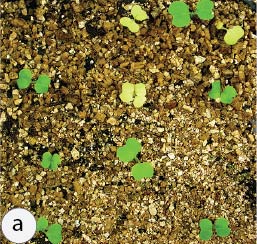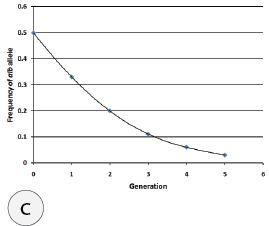
Module 1: Use of the albino mutant allele to explore dominance relationships between wt and mutant alleles, Mendel’s law of segregation, and genetic change over time (evolution)
The albino (alb) FPsc mutant allele is a simple recessive which, in homozygous configuration, has a distinctive yellow/pale green and slow growing phenotype (Figure 1a). alb mutants have a remarkable capacity for persistence; in contrast to canonical albino mutants that germinate, wither and quickly die, alb segregants in an F2 population survive throughout the time it takes wt sibling segregants to complete the plant life cycle, although alb mutants will not flower or set seed under classroom conditions (Figure 1b). In addition to the opportunity to explore Mendelian principles of inheritance, students can be challenged to predict the decline in alb allele frequency through successive generations in a (hypothetical) population (Figure 1c). This scenario represents an extreme example of the means by which deleterious alleles are removed from a population by natural selection—through straightforward Mendelian genetic mechanisms-- but it is a relatively short intellectual leap for for students to appreciate (in less extreme situations) that the frequency of any allelic variant whose effects on reproductive capacity confer a relative fitness < 1.00 will be reduced over time in the gene pool of a population.



Figure 1: The FPsc albino mutant. (a) alb segregants in an F2 population are easily distinguished from wt siblings in as little as 4 days after planting. (b) Despite minimal capacity for photosynthesis, alb mutant segregants persist while wt siblings complete the plant life cycle. (c) By application of straightforward genetic principles students can predict the decline in alb allele frequency over successive generations.
In addition to illustrating fundamental evolutionary principles (mere survival is not enough, reproductive potential is the ultimate measure of evolutionary fitness), the persistence of alb mutant segregants throughout the course of the experiment in genetic analysis will hopefully lead students to ponder the molecular basis of the alb mutant phenotype: What’s gone wrong in these plants? Ambitious educators may opt to engage their students in an experimental initiative that we refer to as the “Albino Rescue Project”. The gist of the initiative is that addition of certain compounds—sucrose (the primary product of photosynthesis), amino acids, vitamins, etc.-- directly to plants or to the growing medium may enhance the ability of alb mutant segregants to produce flowers that are able to pass gametes to the next generation.
Our lab group at the UW is continuing with efforts to localize the alb mutant locus within the B. rapa genome and have obtained tantalizing results based on gene models that suggest candidate compounds that may be of use to promote flowering, but to date we have identified none whose presence in the growth medium successfully “rescues” the infertility phenotype of alb mutant segregants. We would like nothing better than to have legions of teachers and students to help us in this program.
